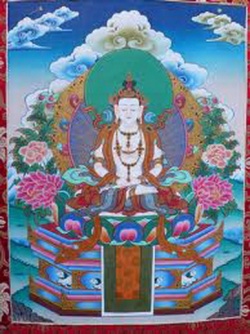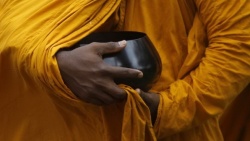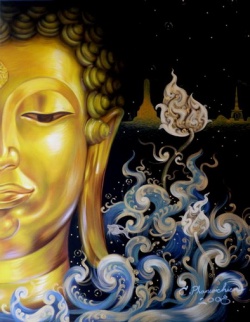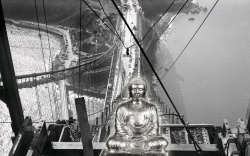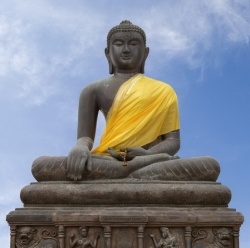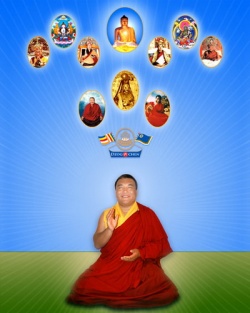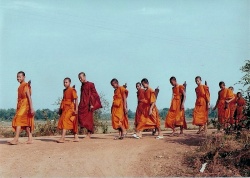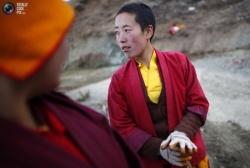Difference between revisions of "What the Buddha Really Taught"
m (Text replacement - "meat" to "meat") |
|||
| (4 intermediate revisions by one other user not shown) | |||
| Line 1: | Line 1: | ||
| − | {{ | + | {{DisplayImages|1922|3330|11|2035|1510|3909|4484|1044|2400|2938}} |
<poem> | <poem> | ||
| − | However, with the exception of the [[Mahāyānist]] interpolations in the Ekottara, which are easily discernible, the variations in question [between the [[Nikāyas]] and [[Āgamas]]] affect hardly anything save the method of expression or the arrangement of the [[subjects]]. The [[doctrinal]] basis common to the [[Nikāyas]] and [[Āgamas]] is remarkably {{Wiki|uniform}}. | + | However, with the exception of the [[Mahāyānist]] interpolations in the [[Ekottara]], which are easily discernible, the variations in question [between the [[Nikāyas]] and [[Āgamas]]] affect hardly anything save the method of expression or the arrangement of the [[subjects]]. The [[doctrinal]] basis common to the [[Nikāyas]] and [[Āgamas]] is remarkably {{Wiki|uniform}}. |
–{{Wiki|Étienne Lamotte}} | –{{Wiki|Étienne Lamotte}} | ||
| Line 14: | Line 14: | ||
When the modern historical study of [[Buddhism]] began in the mid-19th Century there was considerable confusion. In a burst of rationalist enthusiasm, scholars were prepared to question whether the [[myth]] of the [[Buddha]] had any factual basis at all. Was there any historical connection between the different religions practiced in far-separated places like [[Sri Lanka]], [[Tibet]], and [[Japan]]? Did the [[Buddha]] really [[exist]]? Was he just a sun-god? Was he an Ethiopian prophet? What did he teach? Can we know? Which traditions are most reliable (or least unreliable)? Since the traditions had been largely separated due to the forces of history – especially the destruction of [[Buddhism in India]] – they had little information about each other, and each asserted its own primacy. Each school preserved its traditions in vast collections of abstruse volumes of hard-to-read manuscripts in wildly different languages ({{Wiki|Chinese}}, [[Tibetan]], [[Pali]], and other [[Indian]] languages such as [[Sanskrit]]). | When the modern historical study of [[Buddhism]] began in the mid-19th Century there was considerable confusion. In a burst of rationalist enthusiasm, scholars were prepared to question whether the [[myth]] of the [[Buddha]] had any factual basis at all. Was there any historical connection between the different religions practiced in far-separated places like [[Sri Lanka]], [[Tibet]], and [[Japan]]? Did the [[Buddha]] really [[exist]]? Was he just a sun-god? Was he an Ethiopian prophet? What did he teach? Can we know? Which traditions are most reliable (or least unreliable)? Since the traditions had been largely separated due to the forces of history – especially the destruction of [[Buddhism in India]] – they had little information about each other, and each asserted its own primacy. Each school preserved its traditions in vast collections of abstruse volumes of hard-to-read manuscripts in wildly different languages ({{Wiki|Chinese}}, [[Tibetan]], [[Pali]], and other [[Indian]] languages such as [[Sanskrit]]). | ||
| − | But gradually the evidence was assembled. The traditions were compared; archaeological findings confirmed key facts. 1500 year-old [[Sri Lankan]] chronicles mention the names of the [[monks]] [[Kassapa]], [[Majjhima]], and Durabhisara sent in the [[Asokan]] period as missionaries from [[Vidisa]] to the [[Himalayan region]]; a [[stupa]] is excavated in [[Vidisa]] and the names of these [[monks]] are found there, inscribed in letters dating to the [[Aśokan]] {{Wiki|era}}. By the beginning of the 20th Century, in works by such scholars as T.W. Rhys Davies, whose writings retain their value today, accurate outlines were drawn. There was still controversy in the early half of the 20th Century, though, as evidence was still being accumulated, new texts were edited, and new studies done. | + | But gradually the evidence was assembled. The traditions were compared; archaeological findings confirmed key facts. 1500 year-old [[Sri Lankan]] chronicles mention the names of the [[monks]] [[Kassapa]], [[Majjhima]], and [[Durabhisara]] sent in the [[Asokan]] period as missionaries from [[Vidisa]] to the [[Wikipedia:Himalayas|Himalayan region]]; a [[stupa]] is excavated in [[Vidisa]] and the names of these [[monks]] are found there, inscribed in letters dating to the [[Aśokan]] {{Wiki|era}}. By the beginning of the 20th Century, in works by such scholars as T.W. Rhys Davies, whose writings retain their value today, accurate outlines were drawn. There was still controversy in the early half of the 20th Century, though, as evidence was still being accumulated, new texts were edited, and new studies done. |
However, as early as 1882 a [[scholar]] called Samuel Beal published a series of lectures under the title of [[Buddhist]] Literature in [[China]]. This included information on the process of translating into {{Wiki|Chinese}}, as well as sample translations from some of the main strata of [[Buddhist]] literature – the early [[Suttas]], the Jātakas, and a [[Mahāyāna]] text. He stated the following: | However, as early as 1882 a [[scholar]] called Samuel Beal published a series of lectures under the title of [[Buddhist]] Literature in [[China]]. This included information on the process of translating into {{Wiki|Chinese}}, as well as sample translations from some of the main strata of [[Buddhist]] literature – the early [[Suttas]], the Jātakas, and a [[Mahāyāna]] text. He stated the following: | ||
| Line 27: | Line 27: | ||
Although in the popular [[mind]] these texts are [[thought]] of as ‘[[Theravāda]]’ teachings, this is not so. Eminent [[scholar]] [[David Kalupahana]] went so far as to declare that there is not one [[word]] in the [[Pali]] [[Nikāyas]] that represents [[ideas]] peculiar to the [[Theravāda]] school (although I think this is a slight exaggeration.) [[Wikipedia:Étienne Lamotte|Lamotte]] comments: | Although in the popular [[mind]] these texts are [[thought]] of as ‘[[Theravāda]]’ teachings, this is not so. Eminent [[scholar]] [[David Kalupahana]] went so far as to declare that there is not one [[word]] in the [[Pali]] [[Nikāyas]] that represents [[ideas]] peculiar to the [[Theravāda]] school (although I think this is a slight exaggeration.) [[Wikipedia:Étienne Lamotte|Lamotte]] comments: | ||
| − | However, with the exception of the [[Mahāyānist]] interpolations in the [[Ekottara]], which are easily discernible, the variations in question [between the [[Nikāyas]] and Āgamas] affect hardly anything save the method of expression or the arrangement of the subjects. The doctrinal basis common to the [[Nikāyas]] and Āgamas is remarkably uniform. Preserved and transmitted by the schools, the [[sutras]] do not, however, constitute scholastic documents, but are the common heritage of all the sects. | + | However, with the exception of the [[Mahāyānist]] interpolations in the [[Ekottara]], which are easily discernible, the variations in question [between the [[Nikāyas]] and [[Āgamas]] affect hardly anything save the method of expression or the arrangement of the subjects. The doctrinal basis common to the [[Nikāyas]] and Āgamas is remarkably uniform. Preserved and transmitted by the schools, the [[sutras]] do not, however, constitute scholastic documents, but are the common heritage of all the sects. |
“ | “ | ||
The contributions of the schools are mostly limited to fixing the final arrangement of the texts and standardizing the dialect. Interpolations of sectarian [[ideas]] are few and usually readily recognizable. To pick one random example of an apparent sectarian statement, let’s consider what the [[Saṁyutta]] of the [[Theravādins]] and the [[Saṁyukta]] of the [[Sarvāstivādins]] tell us about how the [[four noble truths]] are realized in [[time]]. The [[Theravāda]] says that one who sees any one of the [[four noble truths]] also sees the others (SN 56.30). This [[sutta]], which has no counterpart in the [[Sarvāstivāda]], implies that the [[four truths]] are realized all at once. In contrast, a number of [[Sarvāstivāda]] [[suttas]], which have no [[Theravāda]] counterparts, say that one will come to know each of the [[four noble truths]] in sequence, one after the other (SA 435–437). This relates to the disputed question of sudden ([[ekābhisamaya]]) versus [[gradual]] (anupubbābhisamaya) attainment. Appropriately, the [[Theravāda]] was a classic [[ekābhisamaya]] school, and in their [[Abhidhamma]] they developed the theory that all the [[four noble truths]] were realized in one [[mind]] moment. The [[Sarvāstivādin]] [[Abhidharma]] argued the contrary position, that the [[truths]] were realized gradually. This dispute became one of the major sectarian battlegrounds in later [[Chinese Buddhism]], but its [[roots]] appear already in the [[Saṁyuttas]]. Notice that, while the two schools do differ on this point, the very fact that they share the doctrine of the [[four noble truths]] is what makes this dialogue meaningful. If they didn’t share the basic teachings in common, they couldn’t argue about the details of interpretation. | The contributions of the schools are mostly limited to fixing the final arrangement of the texts and standardizing the dialect. Interpolations of sectarian [[ideas]] are few and usually readily recognizable. To pick one random example of an apparent sectarian statement, let’s consider what the [[Saṁyutta]] of the [[Theravādins]] and the [[Saṁyukta]] of the [[Sarvāstivādins]] tell us about how the [[four noble truths]] are realized in [[time]]. The [[Theravāda]] says that one who sees any one of the [[four noble truths]] also sees the others (SN 56.30). This [[sutta]], which has no counterpart in the [[Sarvāstivāda]], implies that the [[four truths]] are realized all at once. In contrast, a number of [[Sarvāstivāda]] [[suttas]], which have no [[Theravāda]] counterparts, say that one will come to know each of the [[four noble truths]] in sequence, one after the other (SA 435–437). This relates to the disputed question of sudden ([[ekābhisamaya]]) versus [[gradual]] (anupubbābhisamaya) attainment. Appropriately, the [[Theravāda]] was a classic [[ekābhisamaya]] school, and in their [[Abhidhamma]] they developed the theory that all the [[four noble truths]] were realized in one [[mind]] moment. The [[Sarvāstivādin]] [[Abhidharma]] argued the contrary position, that the [[truths]] were realized gradually. This dispute became one of the major sectarian battlegrounds in later [[Chinese Buddhism]], but its [[roots]] appear already in the [[Saṁyuttas]]. Notice that, while the two schools do differ on this point, the very fact that they share the doctrine of the [[four noble truths]] is what makes this dialogue meaningful. If they didn’t share the basic teachings in common, they couldn’t argue about the details of interpretation. | ||
| − | We must, however, remain cautious when drawing conclusions from apparent differences. Even the best scholars can make mistakes, especially as new material is constantly coming to {{Wiki|light}}. For example, [[Thich Minh Chau]], one of the great pioneers of [[Āgama]]/[[Nikāya]] studies, noticed that the [[Jīvaka | + | We must, however, remain cautious when drawing conclusions from apparent differences. Even the best scholars can make mistakes, especially as new material is constantly coming to {{Wiki|light}}. For example, [[Thich Minh Chau]], one of the great pioneers of [[Āgama]]/[[Nikāya]] studies, noticed that the [[Jīvaka Sutta]] of the [[Majjhima Nikāya]] (MN 55) was absent from the corresponding [[Sarvāstivādin]] [[Madhyama Āgama]], and indeed was not found anywhere in the {{Wiki|Chinese}} [[Āgamas]]. This [[sutta]] deals with the question of meat eating. As is well known, [[Theravāda]] monastics usually allow meat eating, while [[Mahāyanists]] generally do not. The [[Theravāda]] [[sutta]], consistent with the practice in [[Theravāda]] cultures, permits meat eating. Thich Minh Chau suggested that its absence from the [[Sarvāstivāda]] indicated that, even from such an early [[time]], the practice of vegetarianism was favoured by the [[Sarvāstivāḍa]]. This conclusion was a reasonable one at the [[time]]. But since then, the [[Sarvāstivāda]] [[Dīrgha Āgama]] has been discovered and partly explored. That collection has a version of the [[Jīvaka]] [[Sutta]] (along with several other important [[Majjhima]] [[suttas]] missing from the [[Sarvāstivāda]] [[Madhyama Āgama]]). So its absence from the [[Madhyama]] is not because of a sectarian difference, but simply because the [[Theravādins]] chose to place it in their [[Majjhima]], while the [[Sarvāstivādins]] chose to place it in their [[Dīrgha]]. |
| − | It is easy to forget that, in our times, the [[reason]] why the [[Nikāyas]] carry such prestige is largely due to the discovery that they are very similar to corresponding collections of [[sutras]] found in {{Wiki|Chinese}} translation. The [[logic]] is powerful: the Southern ([[Theravāda]]) school and the Northern | + | It is easy to forget that, in our times, the [[reason]] why the [[Nikāyas]] carry such prestige is largely due to the discovery that they are very similar to corresponding collections of [[sutras]] found in {{Wiki|Chinese}} translation. The [[logic]] is powerful: the Southern ([[Theravāda]]) school and the [[Northern Chinese schools]] have been separated by vast distances, with only occasional contacts over the {{Wiki|past}} 2000 years. Even before that, within [[India]] herself, the schools had separated and passed down distinct versions of their canonical scriptures. Yet despite this separation, their [[root]] canonical scriptures are doctrinally almost [[identical]]. |
| − | These conclusions were arrived at by the early generations of cross-cultural [[Buddhist]] scholars, both Western and Eastern. Their findings gave strong impetus to the authority of the [[Pali]] [[Nikāyas]] and {{Wiki|Chinese}} Āgamas and the importance of studying these collections on comparative basis. These findings have been taken to [[heart]] in modern [[Buddhist]] studies especially in [[Taiwan]] and [[Japan]]. However in the English speaking [[world]], the {{Wiki|Chinese}} Āgamas have been comparatively neglected. This seems to be due to a number of factors, not least the practical difficulty of learning to read {{Wiki|Chinese}}. | + | These conclusions were arrived at by the early generations of cross-cultural [[Buddhist]] scholars, both Western and Eastern. Their findings gave strong impetus to the authority of the [[Pali]] [[Nikāyas]] and {{Wiki|Chinese}} [[Āgamas]] and the importance of studying these collections on comparative basis. These findings have been taken to [[heart]] in modern [[Buddhist]] studies especially in [[Taiwan]] and [[Japan]]. However in the English speaking [[world]], the {{Wiki|Chinese}} Āgamas have been comparatively neglected. This seems to be due to a number of factors, not least the practical difficulty of learning to read {{Wiki|Chinese}}. |
There is also the assumption that the {{Wiki|Chinese}} translations will be more ‘fuzzy’ and hence less reliable than the [[Indic]] texts. In many psychological and philosophical contexts, the precision of the [[Pali]] is obscured in {{Wiki|Chinese}} translation; and sometimes the vagueness of {{Wiki|Chinese}} grammar makes the problem worse. But while this is true in certain cases, it really depends what one is looking for. Often we can tell with a fair [[degree]] of certainty what [[Indic]] term the {{Wiki|Chinese}} translator had before him. And the ‘fuzziness’ of translation is only relevant at a close focus, when considering the meaning of a particular [[word]]. At a greater distance, for example considering the meaning of a whole sentence, there is often little difference. And when we look at larger textual blocks, for example a whole paragraph, the difference disappears altogether. | There is also the assumption that the {{Wiki|Chinese}} translations will be more ‘fuzzy’ and hence less reliable than the [[Indic]] texts. In many psychological and philosophical contexts, the precision of the [[Pali]] is obscured in {{Wiki|Chinese}} translation; and sometimes the vagueness of {{Wiki|Chinese}} grammar makes the problem worse. But while this is true in certain cases, it really depends what one is looking for. Often we can tell with a fair [[degree]] of certainty what [[Indic]] term the {{Wiki|Chinese}} translator had before him. And the ‘fuzziness’ of translation is only relevant at a close focus, when considering the meaning of a particular [[word]]. At a greater distance, for example considering the meaning of a whole sentence, there is often little difference. And when we look at larger textual blocks, for example a whole paragraph, the difference disappears altogether. | ||
| Line 48: | Line 48: | ||
[[Āgamas]] & [[Nikāyas]] [[Theravāda]] [[Nikāyas]] [[Sarvāstivāda]] [[Āgamas]] Other [[Āgamas]] (in {{Wiki|Chinese}}) | [[Āgamas]] & [[Nikāyas]] [[Theravāda]] [[Nikāyas]] [[Sarvāstivāda]] [[Āgamas]] Other [[Āgamas]] (in {{Wiki|Chinese}}) | ||
| − | [[Dīgha]] ([[Pali]]) Dīrgha ([[Sanskrit]]) T1 Dīrgha ([[Dharmaguptaka]], trans. [[Buddhayaśas]]) | + | [[Dīgha]] ([[Pali]]) [[Dīrgha]] ([[Sanskrit]]) T1 [[Dīrgha]] ([[Dharmaguptaka]], trans. [[Buddhayaśas]]) |
[[Majjhima]] ([[Pali]]) T26 [[Madhyama]] ({{Wiki|Chinese}} trans. [[Gotama Saṅghadeva]]) | [[Majjhima]] ([[Pali]]) T26 [[Madhyama]] ({{Wiki|Chinese}} trans. [[Gotama Saṅghadeva]]) | ||
| Line 58: | Line 58: | ||
The [[Sarvāstivāda]] [[Dīrgha]] is an exciting find: an {{Wiki|ancient}} [[Sanskrit]] manuscript, two-thirds of which have mysteriously appeared from Afghanistan in recent years. It has not yet been edited and published. When this is available, it will be seen that we have a nearly complete collection of [[sutras]] from the [[Sarvāstivāda]] school. In addition there is the Dīrgha from the [[Dharmaguptaka]] school. The school of the [[Ekottara]] is really unknown, though some scholars tentatively assign it to the [[Mahāsaṅghikas]]. These are all [[early schools of Buddhism]] that thrived in {{Wiki|ancient India}}. The fifth [[Pali]] [[Nikāya]], the [[Khuddaka]], is a miscellaneous collection, containing a mix of early and late material. While there is occasional reference in the {{Wiki|Chinese}} and [[Tibetan]] canons to a [[Kśudraka Āgama]] there is no existing counterpart of the collection as a whole. Nevertheless, there are many existing counterparts to sections of the [[Khuddaka]], including the [[Dhammapada]], [[Jatakas]], [[Aṭṭhakavagga]], and so on. | The [[Sarvāstivāda]] [[Dīrgha]] is an exciting find: an {{Wiki|ancient}} [[Sanskrit]] manuscript, two-thirds of which have mysteriously appeared from Afghanistan in recent years. It has not yet been edited and published. When this is available, it will be seen that we have a nearly complete collection of [[sutras]] from the [[Sarvāstivāda]] school. In addition there is the Dīrgha from the [[Dharmaguptaka]] school. The school of the [[Ekottara]] is really unknown, though some scholars tentatively assign it to the [[Mahāsaṅghikas]]. These are all [[early schools of Buddhism]] that thrived in {{Wiki|ancient India}}. The fifth [[Pali]] [[Nikāya]], the [[Khuddaka]], is a miscellaneous collection, containing a mix of early and late material. While there is occasional reference in the {{Wiki|Chinese}} and [[Tibetan]] canons to a [[Kśudraka Āgama]] there is no existing counterpart of the collection as a whole. Nevertheless, there are many existing counterparts to sections of the [[Khuddaka]], including the [[Dhammapada]], [[Jatakas]], [[Aṭṭhakavagga]], and so on. | ||
| − | The [[Tibetan canon]] does not contain any major [[Āgamas]] of early [[sutras]]. This seems to be because by the [[time]] [[Buddhism]] went to [[Tibet]], from around 700CE, there was not much [[interest]] in studying the [[Āgama]] [[sutras]]. Nevertheless, there are fair amounts of early [[sutras]] scattered through the vast [[Tibetan]] collection, individually or in small groups. In addition, there are a fair number of quotes and references to [[Āgama]] [[sutras]] found embedded in later treatises. So although the Āgamas themselves are sadly absent in [[Tibetan]], they are acknowledged and accepted as [[Wikipedia:canonical|canonical]]. | + | The [[Tibetan canon]] does not contain any major [[Āgamas]] of early [[sutras]]. This seems to be because by the [[time]] [[Buddhism]] went to [[Tibet]], from around 700CE, there was not much [[interest]] in studying the [[Āgama]] [[sutras]]. Nevertheless, there are fair amounts of early [[sutras]] scattered through the vast [[Tibetan]] collection, individually or in small groups. In addition, there are a fair number of quotes and references to [[Āgama]] [[sutras]] found embedded in later treatises. So although the [[Āgamas]] themselves are sadly absent in [[Tibetan]], they are acknowledged and accepted as [[Wikipedia:canonical|canonical]]. |
By examining the collections of texts side by side, we can determine to what extent the schools may have introduced their own [[ideas]] into the canons. This process, happily enough, reveals that sectarian [[ideas]] are almost completely absent. Only here and there, searching with a critical [[eye]], can one tentatively discern minor sectarian influences. The most reasonable explanation for this situation is that these texts were already accepted across the [[Buddhist]] community as canonical well before the period of {{Wiki|schisms}}. | By examining the collections of texts side by side, we can determine to what extent the schools may have introduced their own [[ideas]] into the canons. This process, happily enough, reveals that sectarian [[ideas]] are almost completely absent. Only here and there, searching with a critical [[eye]], can one tentatively discern minor sectarian influences. The most reasonable explanation for this situation is that these texts were already accepted across the [[Buddhist]] community as canonical well before the period of {{Wiki|schisms}}. | ||
Latest revision as of 13:54, 30 December 2014
However, with the exception of the Mahāyānist interpolations in the Ekottara, which are easily discernible, the variations in question [between the Nikāyas and Āgamas] affect hardly anything save the method of expression or the arrangement of the subjects. The doctrinal basis common to the Nikāyas and Āgamas is remarkably uniform.
–Étienne Lamotte
by how many books there are. Shelves crammed full of people’s opinions about ‘what the Buddha taught’. But try to find something that actually contains the Buddha’s teaching and you’re in for a much harder time. It seems to be okay to be a Buddhist, attend talks, read books, meditate, chant, and go on retreat, without ever bothering to ask oneself the question: what did the Buddha really teach?
For the rare and brave seeker who dares to inquire beyond what their teachers tell them, it will not take long before they hear of the Pali Nikāyas. Here, we are told, is the original unadulterated Teaching. The Buddha’s words in their pristine purity. We are in the enviable position of having many excellent translations of these texts available in English, both in books and on the web. Anyone with sufficient time and interest can, with a little perseverance, gain a reasonable understanding of these teachings. The Pali Nikāyas have been one of my formative influences, right from my first days as a Buddhist. The Dhamma they embody is clear, rational, balanced, gentle, and profound – everything one could hope for.
But it is easy to fall into a kind of ‘Pali fundamentalism’. The texts and language are so pure and precise that many of us who fall in love with the Nikāyas end up believing that they constitute the be-all and end-all of Buddhism. We religiously adhere to the finest distinction, the most subtle interpretation, based on a single word or phrase. We take for granted that here we have the original teaching, without considering the process by which these teachings have passed down to us. In our fervour, we neglect to wonder whether there might be another perspective on these Dhammas.
Perhaps most important of all, we forget – if we ever knew – the reasons why we are justified in considering the Nikāyas authentic in the first place. While it is good enough for most faith-based Buddhists to believe that their own scriptures are the only real ones, this will not suffice for a disinterested seeker. Any religious tradition will try to validate itself by such claims, and they can’t all be right. These conflicting claims led the early researchers in the modern era to examine the evidence more objectively.
When the modern historical study of Buddhism began in the mid-19th Century there was considerable confusion. In a burst of rationalist enthusiasm, scholars were prepared to question whether the myth of the Buddha had any factual basis at all. Was there any historical connection between the different religions practiced in far-separated places like Sri Lanka, Tibet, and Japan? Did the Buddha really exist? Was he just a sun-god? Was he an Ethiopian prophet? What did he teach? Can we know? Which traditions are most reliable (or least unreliable)? Since the traditions had been largely separated due to the forces of history – especially the destruction of Buddhism in India – they had little information about each other, and each asserted its own primacy. Each school preserved its traditions in vast collections of abstruse volumes of hard-to-read manuscripts in wildly different languages (Chinese, Tibetan, Pali, and other Indian languages such as Sanskrit).
But gradually the evidence was assembled. The traditions were compared; archaeological findings confirmed key facts. 1500 year-old Sri Lankan chronicles mention the names of the monks Kassapa, Majjhima, and Durabhisara sent in the Asokan period as missionaries from Vidisa to the Himalayan region; a stupa is excavated in Vidisa and the names of these monks are found there, inscribed in letters dating to the Aśokan era. By the beginning of the 20th Century, in works by such scholars as T.W. Rhys Davies, whose writings retain their value today, accurate outlines were drawn. There was still controversy in the early half of the 20th Century, though, as evidence was still being accumulated, new texts were edited, and new studies done.
However, as early as 1882 a scholar called Samuel Beal published a series of lectures under the title of Buddhist Literature in China. This included information on the process of translating into Chinese, as well as sample translations from some of the main strata of Buddhist literature – the early Suttas, the Jātakas, and a Mahāyāna text. He stated the following:
The Parinibbāna, the Brahmajāla, the Sigalovada, the Dhammacakka, the KasiBhāradvadja, the Mahāmangala; all these I have found and compared with translations from the Pali, and find that in the main they are identical. I do not say literally the same; they differ in minor points, but are identical in plot and all important details. And when the Vinaya and Āgama collections are thoroughly examined, I can have little doubt we shall find most if not all the Pali suttas in a Chinese form.
“
Over a century later, the thorough comparative study urged by Beal is still wanting. However, some progress has been made. In 1908 the Japanese scholar M. Anesaki published his ‘The Four Buddhist Āgamas in Chinese: A concordance of their parts and of the corresponding counterparts in the Pali Nikāyas’. This was followed in 1929 by Chizen Akanuma’s The Comparative Catalogue of Chinese Āgamas and Pali Nikāyas, a comprehensive catalogue of all known existing early discourses in Pali and Chinese, as well as the few early texts available in Tibetan and Sanskrit. These findings were incorporated in full-scale historical studies such as Étienne Lamotte’s History of Indian Buddhism and A.K. Warder’s Indian Buddhism.
These studies have largely confirmed Beal’s initial hypothesis – the Chinese Āgamas and the Pali Nikāyas are virtually identical in doctrine. They are two varying recensions of the same set of texts. These texts – popularly referred to simply as ‘the Suttas’ – were assembled by the first generations of the Buddha’s followers, before the period of sectarian divisions. They are pre-sectarian Buddhism.
Although in the popular mind these texts are thought of as ‘Theravāda’ teachings, this is not so. Eminent scholar David Kalupahana went so far as to declare that there is not one word in the Pali Nikāyas that represents ideas peculiar to the Theravāda school (although I think this is a slight exaggeration.) Lamotte comments:
However, with the exception of the Mahāyānist interpolations in the Ekottara, which are easily discernible, the variations in question [between the Nikāyas and Āgamas affect hardly anything save the method of expression or the arrangement of the subjects. The doctrinal basis common to the Nikāyas and Āgamas is remarkably uniform. Preserved and transmitted by the schools, the sutras do not, however, constitute scholastic documents, but are the common heritage of all the sects.
“
The contributions of the schools are mostly limited to fixing the final arrangement of the texts and standardizing the dialect. Interpolations of sectarian ideas are few and usually readily recognizable. To pick one random example of an apparent sectarian statement, let’s consider what the Saṁyutta of the Theravādins and the Saṁyukta of the Sarvāstivādins tell us about how the four noble truths are realized in time. The Theravāda says that one who sees any one of the four noble truths also sees the others (SN 56.30). This sutta, which has no counterpart in the Sarvāstivāda, implies that the four truths are realized all at once. In contrast, a number of Sarvāstivāda suttas, which have no Theravāda counterparts, say that one will come to know each of the four noble truths in sequence, one after the other (SA 435–437). This relates to the disputed question of sudden (ekābhisamaya) versus gradual (anupubbābhisamaya) attainment. Appropriately, the Theravāda was a classic ekābhisamaya school, and in their Abhidhamma they developed the theory that all the four noble truths were realized in one mind moment. The Sarvāstivādin Abhidharma argued the contrary position, that the truths were realized gradually. This dispute became one of the major sectarian battlegrounds in later Chinese Buddhism, but its roots appear already in the Saṁyuttas. Notice that, while the two schools do differ on this point, the very fact that they share the doctrine of the four noble truths is what makes this dialogue meaningful. If they didn’t share the basic teachings in common, they couldn’t argue about the details of interpretation.
We must, however, remain cautious when drawing conclusions from apparent differences. Even the best scholars can make mistakes, especially as new material is constantly coming to light. For example, Thich Minh Chau, one of the great pioneers of Āgama/Nikāya studies, noticed that the Jīvaka Sutta of the Majjhima Nikāya (MN 55) was absent from the corresponding Sarvāstivādin Madhyama Āgama, and indeed was not found anywhere in the Chinese Āgamas. This sutta deals with the question of meat eating. As is well known, Theravāda monastics usually allow meat eating, while Mahāyanists generally do not. The Theravāda sutta, consistent with the practice in Theravāda cultures, permits meat eating. Thich Minh Chau suggested that its absence from the Sarvāstivāda indicated that, even from such an early time, the practice of vegetarianism was favoured by the Sarvāstivāḍa. This conclusion was a reasonable one at the time. But since then, the Sarvāstivāda Dīrgha Āgama has been discovered and partly explored. That collection has a version of the Jīvaka Sutta (along with several other important Majjhima suttas missing from the Sarvāstivāda Madhyama Āgama). So its absence from the Madhyama is not because of a sectarian difference, but simply because the Theravādins chose to place it in their Majjhima, while the Sarvāstivādins chose to place it in their Dīrgha.
It is easy to forget that, in our times, the reason why the Nikāyas carry such prestige is largely due to the discovery that they are very similar to corresponding collections of sutras found in Chinese translation. The logic is powerful: the Southern (Theravāda) school and the Northern Chinese schools have been separated by vast distances, with only occasional contacts over the past 2000 years. Even before that, within India herself, the schools had separated and passed down distinct versions of their canonical scriptures. Yet despite this separation, their root canonical scriptures are doctrinally almost identical.
These conclusions were arrived at by the early generations of cross-cultural Buddhist scholars, both Western and Eastern. Their findings gave strong impetus to the authority of the Pali Nikāyas and Chinese Āgamas and the importance of studying these collections on comparative basis. These findings have been taken to heart in modern Buddhist studies especially in Taiwan and Japan. However in the English speaking world, the Chinese Āgamas have been comparatively neglected. This seems to be due to a number of factors, not least the practical difficulty of learning to read Chinese.
There is also the assumption that the Chinese translations will be more ‘fuzzy’ and hence less reliable than the Indic texts. In many psychological and philosophical contexts, the precision of the Pali is obscured in Chinese translation; and sometimes the vagueness of Chinese grammar makes the problem worse. But while this is true in certain cases, it really depends what one is looking for. Often we can tell with a fair degree of certainty what Indic term the Chinese translator had before him. And the ‘fuzziness’ of translation is only relevant at a close focus, when considering the meaning of a particular word. At a greater distance, for example considering the meaning of a whole sentence, there is often little difference. And when we look at larger textual blocks, for example a whole paragraph, the difference disappears altogether.
As an example of this, consider the term 覺 (jue2). This can carry a variety of meanings, usually connected with bodhi, awakening or enlightenment. But what are we to make of this term when it appears in the formula for the first jhana: 有覺有觀 ‘with 覺, with investigation’? Here 覺 cannot stand for bodhi or anything similar. Now, the jhana formula is very common and standard throughout the Nikāyās/Āgamas. We can be fairly certain that 覺 must stand for the corresponding Pali term vitakka (‘thought’, or ‘initial application of mind’). This is confirmed when we see that in Sanskrit texts that closely relate to the originals from which the Chinese was translated, the term used is indeed vitarka. Having established this, whenever we see the term appearing in the jhana formula, we know that it means vitakka, and we know this with as much certainty as if we had read the Indic original. So in such cases, the Chinese translations are just as accurate and authoritative as the Pali, and sometimes may even be more reliable.
Another possible reason for the relative neglect of the Āgamas in the English-speaking world is the perception that they are later than the Nikāyas. This impression has been reinforced by no less an eminence than Étienne Lamotte, whose opinion has been often repeated. But his main reason for this conclusion was that the Chinese Saṁyukta Āgama included a long passage from a late ‘Life of King Aśoka’. However, Japanese and Taiwanese scholars have long recognized that this is an alien interpolation into the Saṁyukta, probably nothing more than a filing error by a careless librarian sometime in China. A closer examination of the content of the Āgamas suggests that they are generally speaking neither earlier nor later than the Nikāyas, but rather both sets collected materials over roughly the same period of time.
It is beyond the scope of this little essay to examine the various collections in detail, but we can review the basics. Here is a table of the main existing collections. The ‘T’ numbers refer to the sutra numbers in the standard Taishō edition of the Chinese canon.
Āgamas & Nikāyas Theravāda Nikāyas Sarvāstivāda Āgamas Other Āgamas (in Chinese)
Dīgha (Pali) Dīrgha (Sanskrit) T1 Dīrgha (Dharmaguptaka, trans. Buddhayaśas)
Majjhima (Pali) T26 Madhyama (Chinese trans. Gotama Saṅghadeva)
Saṁyutta (Pali) T99 Saṁyukta (Chinese trans. Guṇabhadra) Two ‘other’ Saṁyuktas (T100, T101, unknown schools)
Aṅguttara (Pali) T125 Ekottara (Mahāsaṅghika? trans. Gotama Saṅghadeva)
The Sarvāstivāda Dīrgha is an exciting find: an ancient Sanskrit manuscript, two-thirds of which have mysteriously appeared from Afghanistan in recent years. It has not yet been edited and published. When this is available, it will be seen that we have a nearly complete collection of sutras from the Sarvāstivāda school. In addition there is the Dīrgha from the Dharmaguptaka school. The school of the Ekottara is really unknown, though some scholars tentatively assign it to the Mahāsaṅghikas. These are all early schools of Buddhism that thrived in ancient India. The fifth Pali Nikāya, the Khuddaka, is a miscellaneous collection, containing a mix of early and late material. While there is occasional reference in the Chinese and Tibetan canons to a Kśudraka Āgama there is no existing counterpart of the collection as a whole. Nevertheless, there are many existing counterparts to sections of the Khuddaka, including the Dhammapada, Jatakas, Aṭṭhakavagga, and so on.
The Tibetan canon does not contain any major Āgamas of early sutras. This seems to be because by the time Buddhism went to Tibet, from around 700CE, there was not much interest in studying the Āgama sutras. Nevertheless, there are fair amounts of early sutras scattered through the vast Tibetan collection, individually or in small groups. In addition, there are a fair number of quotes and references to Āgama sutras found embedded in later treatises. So although the Āgamas themselves are sadly absent in Tibetan, they are acknowledged and accepted as canonical.
By examining the collections of texts side by side, we can determine to what extent the schools may have introduced their own ideas into the canons. This process, happily enough, reveals that sectarian ideas are almost completely absent. Only here and there, searching with a critical eye, can one tentatively discern minor sectarian influences. The most reasonable explanation for this situation is that these texts were already accepted across the Buddhist community as canonical well before the period of schisms.
This does not mean that everything found in these texts is literally the ‘Word of the Buddha’. The first schism was over 100 years after the Buddha’s parinibbana, which allows plenty of time for editorial funny business. The texts themselves remind us that what is essential are ‘those suttas spoken by the Tathagata’. Much of the material in the early Nikāyas/Āgamas is not ‘spoken by the Tathagata’, for example, background stories and narrative. This should not be regarded as authoritative in the deep sense. And indeed, comparison between corresponding sutras in the Nikāyas and Āgamas frequently reveals that, while the doctrinal matter is very similar, the setting and other incidental details may be different. This is not a hard-and-fast rule, but shows a tendency in the compilation of the canon to regard doctrinal matter as the heart, and treat incidental matter more freely. There are even instructions in two Vinayas on what to do if one forgets the setting of a sutra. These more-or-less instruct the monks to just say it was at Sāvatthī!
Perhaps another reason for the relative neglect of the Āgamas is their very closeness to the Nikāyas. We have to go to a lot of effort to discover what we think we know already: the core Buddhist teachings really are the four noble truths, the eightfold path, dependent origination, and so on. Although there are occasional instructive variations, the main fruit of this study is not in the content of the teaching, but in the method. Rather than assuming that the scriptures of just one school are the first and last word on what the Buddha taught, we are searching in the root teachings shared in common between the schools. Such an approach will not only help us to get ‘back to the Buddha’, but it will provide the best platform for an improved understanding between the Buddhist schools we find alive today.
I started out this essay by criticizing ‘Pali fundamentalism’; but we must also beware of becoming ‘pre-sectarian’ fundamentalists! The teachings of the various schools are not just a sheer mass of error and meaningless corruption, any more than they are iron-clad formulations of ‘ultimate truth’. They are the answers given by teachers of old to the question: ‘What does Buddhism mean for us?’ Each succeeding generation must undertake the delicate task of hermeneutics, the re-acculturation of the Dhamma in time and place. And in our times, so different from those of any Buddhist era or culture of the past, we must find our own answers. Looked at from this perspective, the teachings of the schools offer us invaluable lessons, a wealth of precedent bequeathed us by our ancestors in faith. Just as the great Theravādin commentator Buddhaghosa employed an encyclopaedic knowledge of the Nikāyas, many of the greatest ‘Mahāyāna’ scholars, such as Nāgārjuna, Vasubandhu, and Asaṅga, based themselves securely on the Āgamas. By following their example and making the effort to thoroughly learn these Teachings we can understand, practice, and propagate the living Dhamma for the sake of all sentient beings.
